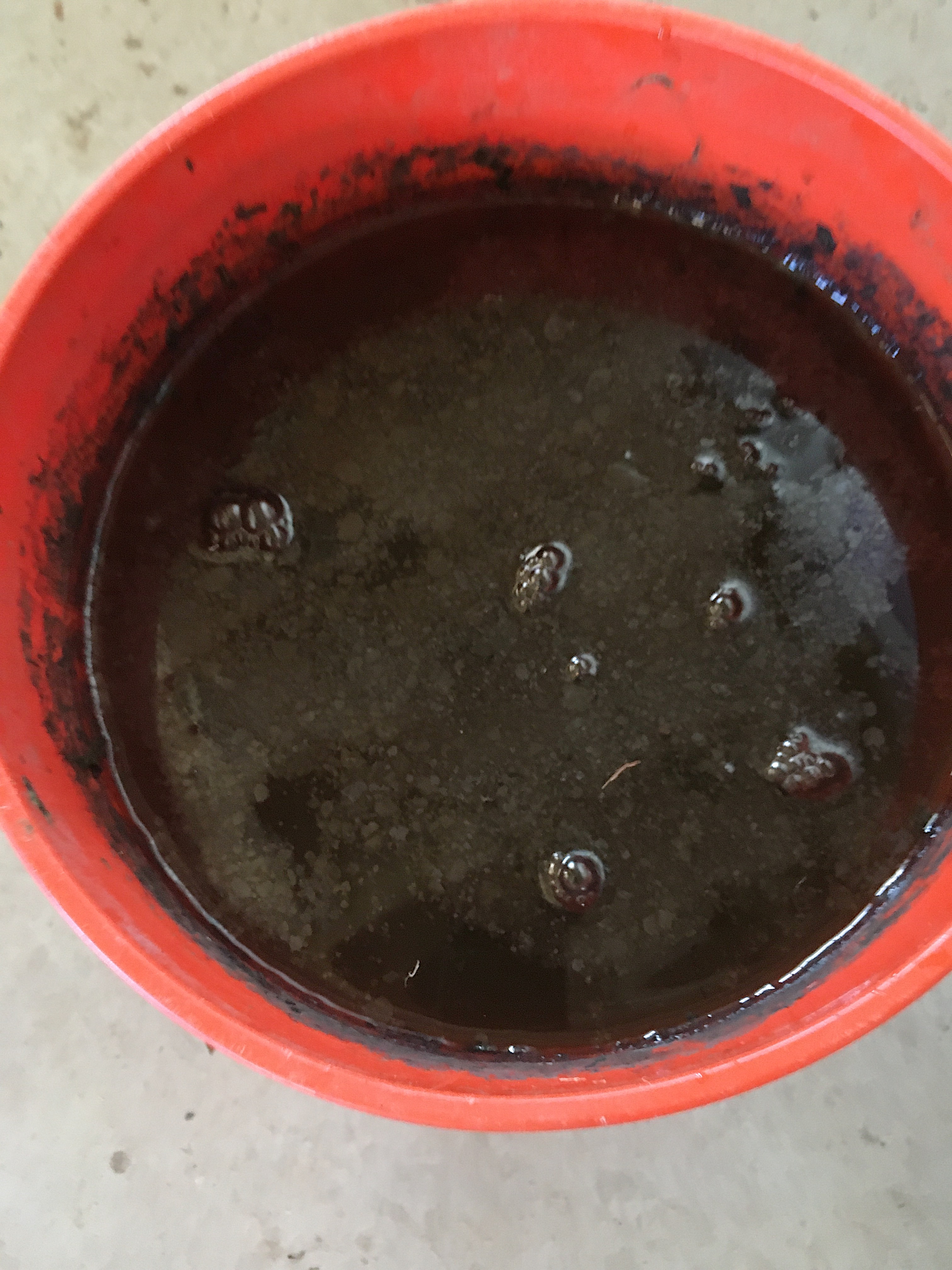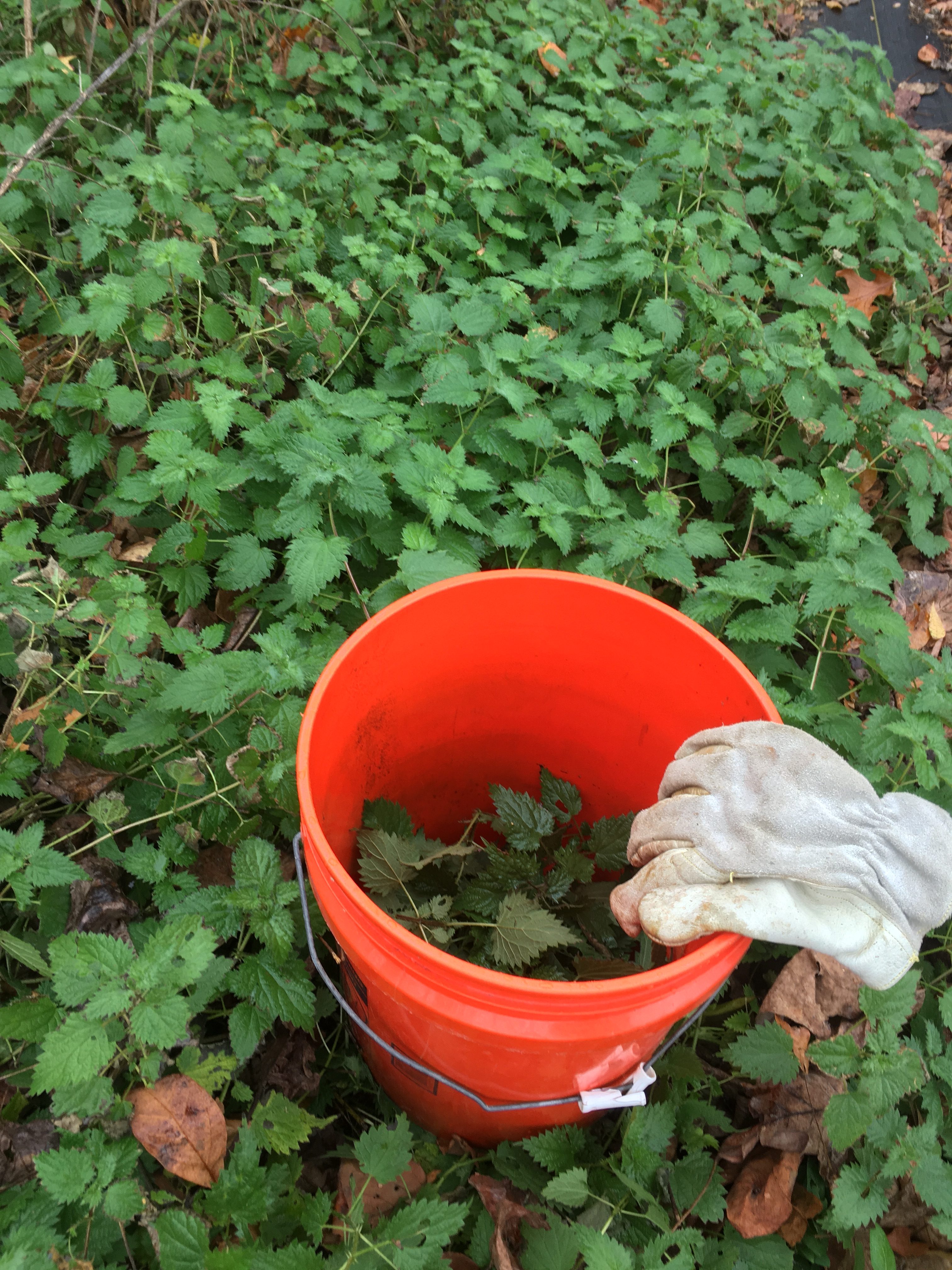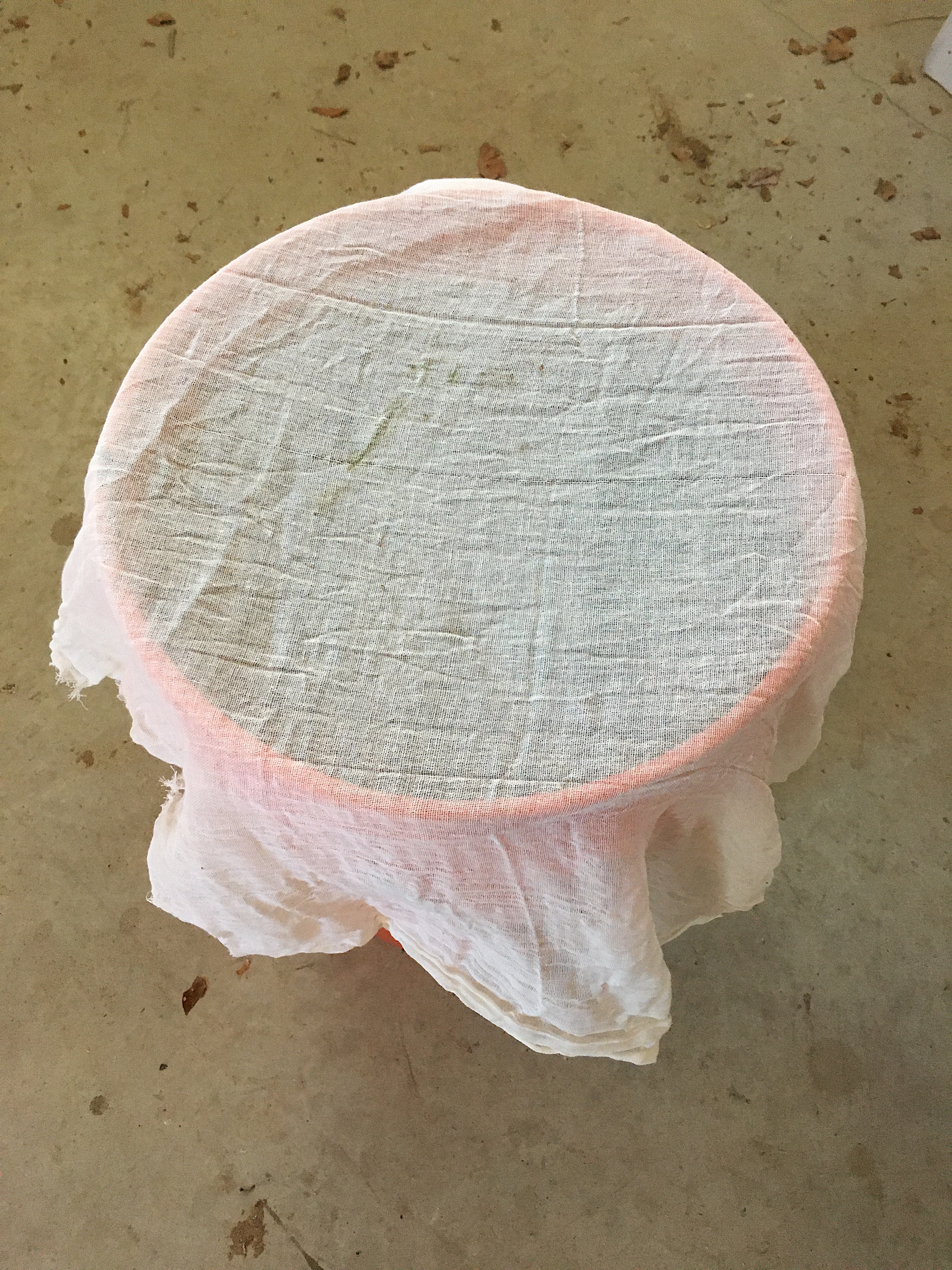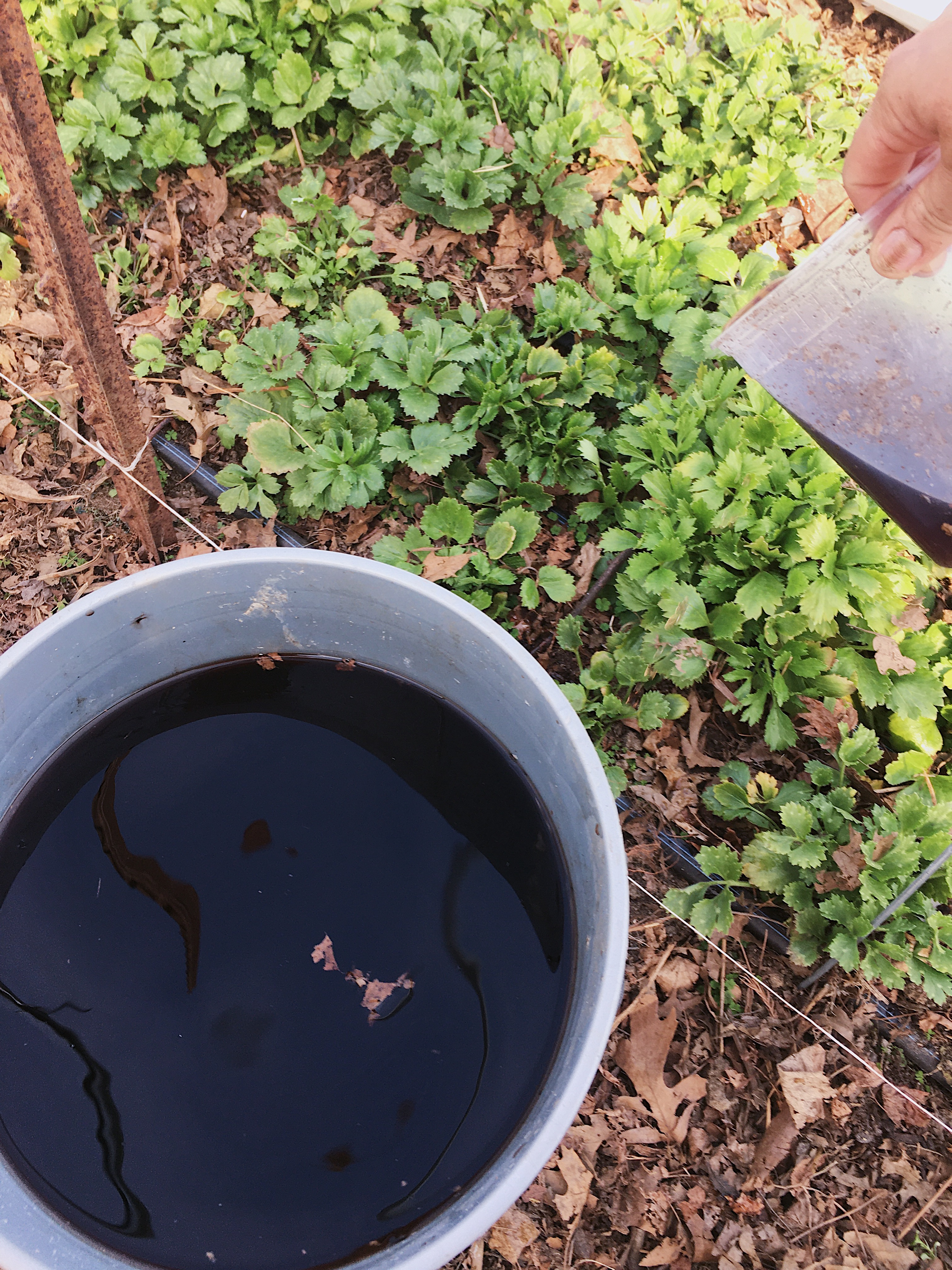
This is the third in a short series of blog posts on easy homemade regenerative inputs for your farm and garden. If you missed the previous two posts, be sure to check out how to make Leaf Mold Tea and Eggshell Extract. Once you’ve caught up with those, it’s time to talk about my favorite of all homemade regenerative inputs: Weed Juice. Why is it my favorite? Because it gives me a whole new appreciation for weeds, so much so that I’ve even gone begging my neighbors for some of theirs!
While I call this concoction “Weed Juice” because I use plant material from what many people consider “weeds”, you may have already come across the concept. Comfrey tea, nettle tea, and JADAM Liquid Fertilizer (JLF) are all versions of this. I first read about steeping plant material in a bucket for months until it disintegrated in a gardening book Garden Anywhere by UK-based author, Alys Fowler, more than a decade ago. She wrote about using comfrey tea as a natural fertilizer. I remember trying it one time back then; it was the foulest smelling stuff ever! I couldn’t stomach making it again and pretty much assumed all British gardeners must be a little nuts if they were using that stuff.
Fast forward several years and I started learning a lot more about homemade regenerative inputs for the farm thanks my curiosity about Korean Natural Farming and JADAM. I read about JLF (yet another unfortunately awkward acronym that scares so many of the initiated away from KNF and JADAM) and made some using nettles. Just like that bygone bucket of comfrey tea, the stench was pretty darn bad. However, I was delighted with the results: when applied to rows of young transplants, their leaves became glossy and vibrant! The stink was worth it!
But it was while reading the book, When Weeds Talk by Jay McCaman, that some seemingly disjointed pieces clicked into place beautiful in my mind. JLF became “Weed Juice” and I got pretty carried away with it. To explain why, I’ll first need to tell you about The Rule of Return.
For starters, let’s take a moment to pointedly acknowledge that all of this trendy “regenerative farming” talk we are immersed in today is not new or groundbreaking. Critical and important, yes. But not new! Discussions of naturally balancing the soil and the ecosystem at the farm level through a closed loop system have been around for many decades. There is much to be learned from older books if you’re willing to take some time to dig around and find them. For one, in the 1940s and 50s, Dr. William Albrecht was writing extensively on the subject of soil health and biology, rallying against the “modernization” of American farming and its use of then-new synthetic fertilizers and large machinery. If only more farmers had listened to him then!
I am not sure if it was Dr. Albrecht or one of his contemporaries (possibly Lady Eve Balfour – yes a female farmer!!) who originally coined the phrase “Law of Return”. [I’ve since bastardized it in my own mind to refer to it as the Rule of Return because the writer in me likes alliteration.] In short, nature requires that whatever is taken out of a soil ecosystem must be returned to it in order for the soil to continue on in a balanced and healthy manner.
It makes complete sense when you think about the simple (and yet beautifully complex) function of a mature deciduous tree. The tree pulls nutrients from the soil all throughout the spring and summer to develop leaves that enable it to prosper. Then in the fall, the leaves drop to the ground to return nutrients to the soil and the life therein. Next spring the tree accesses those processed minerals and nutrients to stretch its limbs even further. And so the cycle continues effortlessly it would seem. Or at least until some stupid human decides they don’t like leaves on their lawn and they hire a posse of leaf-blower wielding landscapers to vacuum up the leaves and haul them away. Grr.
As farmers, what we take off the land must be returned to the land in some way. This is the golden Rule of Return. It cannot be broken or ignored without consequence. But all too often, we farmers are not putting enough back. Especially flower farmers who take massive amounts of plant biomass off the farm with each vanload of blooms. I know I’ve been guilty of this more than I care to admit.
As I was contemplating the Rule of Return, I was also reading Jay McCaman’s book, all about what weeds can tell us about our fields. While his discourse can be rather disjointed by times, he does bring to the forefront of the readers mind the idea that weeds are not “bad guys”, but rather the talisman of soil balancing. With their root systems reaching into the subsoil, weeds are mining the minerals needed to bring tired topsoil back into balance again. For example, when a soil is low in calcium, crabgrass, sorrel and chickweed will proliferate, on a mission to bring that calcium up from deep down and make it available to the soil food web near the surface. Once their mission to bring calcium into balance is complete (usually after a handful of generations that grow, die and decay in place), those types of weeds will dissipate, making way for the next set of species to take over.
But if we, as farmers and gardeners, pull up the weeds and cart them away, we are denying the Rule of Return. Yes, we could supplement with another amendment we buy and have shipped to the farm to be spread around between bed flips. But why do all of that when Nature has already done half the work for us and just wants to complete this cycle of mineral balancing as intended?
“Well, Jennie, you can’t very well just stop weeding and let the place go to hell in a handbasket!” Trust me, I know you can’t skip the laborious task of weeding. But what if you could flip the script on that chore and consider it to be a type of harvesting instead? Harvesting nutrients! Now you’ll love your weeds! And maybe even covet your neighbors if they’ve got nettles, yarrow, or comfrey growing wild.

The process is so darn easy too! By fermenting weeds in rainwater to make Weed Juice, you’ll be able to extract all those minerals the weeds were mining and put them right back into your farm’s soil via irrigation or drenching, ultimately feeding your crops, balancing the soil, and reducing future weed growth. The Rule of Return is being met and the farmer’s job becomes a little bit easier and more pleasant. Win-win! Oh, and it’s free! Win-win-win!!
Start with making five gallon batches like outlined below in the recipe. Once you get into the swing of it, consider scaling up! This will look different at each farm. At mine, I’ve installed a rain catchment system off my barn, culminating in a 750 gallon tank so I have plenty of rainwater for making Weed Juice and for the other homemade regenerative inputs and foliar feeds I’m making. This spring I’m also installing a series of 55 gallon drums next to the rain tank where I’ll be fermenting Weed Juice on a larger scale that will then get pumped through my drip irrigation system. I’m so excited!
P.S. – I’m not going to lie to you. This is still a very stinky input but somehow more bearable when you think about the Rule of Return. Or at least I think so!
WEED JUICE (aka JLF)
Goal: To extract the minerals out of the plant material via a long-term fermentation process. A little bit of biology is also likely included with the end product, but this input is mostly about nutrients (unlike Leaf Mold Tea, which is primarily about ramping up biology in the soil).
Any type of weed or crop reside (i.e., the tops of dahlias when you pinch them back) will work here, but I would encourage you to scout your farm for your most common weeds and make an inventory list of your Top 5 and then focus on making batches of Weed Juice specific to those and consciously using the resulting liquid around the same areas where those weeds have proven to be a problem. Observe what happens!
Ingredients
A big pile of freshly pulled weeds
Rainwater (well water can also work, but do not used treated municipal water)
A handful of leaf mold freshly gathered from under a healthy tree
Tools
5 gallon bucket
Cheese Cloth and/or piece of board*
Something to label the bucket
To Make:
Shake off all the dirt from the roots of the weeds. You can also just cut/pull roots from the plant tops if that’s easier.
Working with just the green materials (no dirt), chop up the weeds/plant material with scissors (or use a mulching push mower if you’re handling large volumes). Place chopped up plant debris in the bucket, filling it about three quarters of the way full when stuffed in.
Add water to cover the plant material completely, filling nearly to the top of the bucket.
Sprinkle the leaf mold over the surface of the water in the bucket. Do not stir it in; just let it float on the top. The leaf mold adds some biology to the mix that will help decompose the debris faster.
Cover the bucket with the cheesecloth and the board. Label the bucket with the date and contents so you remember several months from now what exactly was in there!
Set the bucket in a place away from sun and rain, but ideally not inside a building where you’ll be close to it often. The contents will stink so you want plenty of airflow! I use the back porch off my barn during the summer and then bring any remaining buckets inside for the winter so they don’t freeze.

Let contents sit for several months, stirring occasionally with a stick. Hold your nose when you stir! When the bucket is not actively stirred, it doesn’t smell too badly unless you get right up close to it. You want the plant material to fully dissolve. Usually my batches take about two months during warmer weather and four months during colder months. Letting it sit for an entire year is apparently ideal, but I’ve never been able to hold off that long before I wanted to use mine. You can actually start using it after just a few weeks, but you won’t be maximizing the mineral content if you use it before the plant material is fully dissolved.
*You may also use a proper lid for the bucket and seal it up completely. In JADAM, it is actually recommended that the container holding JLF be sealed because air is not desirable for fermentation. I personally found sealed buckets just way too stinky for my stomach to handle. By letting air in throughout the fermentation process, there seems to be a little less stench. But if you have no choice but to hold these buckets in an enclosed area, you’ll probably want to seal them off and only work with the finished contents outdoors. To get a visual for all of this, check out Tony and Denise’s amusing video over on the Bare Mountain Farm Youtube channel.
To Use:
To use as a soil drench, I add about 1 cup of Weed Juice to each gallon of water. The dilution rate recommend varies from source to source in the reference materials: Fowler’s Garden Anywhere doesn’t recommend diluting the comfrey tea at all; Nigel Palmer recommends a 1:20 dilution rate in his book The Regenerative Grower’s Guide to Garden Amendments (he calls this Leaf Mold Fermentation, by the way); and JADAM itself recommends a dilution ratio of about 1:200 to 1:500. I suspect the range of recommended dilution rates has a lot to do with which weed is the base and how your soil might hold onto nutrients (sandy soil leaches nutrients and so low dilution rate would be better; heavy clay soil can hold onto nutrients so a higher dilution rate would be better.
To use as a foliar feed, I use 1 tablespoon of Weed Juice per gallon of water and apply with a backpack sprayer. I usually only use Weed Juice made with nettles for foliar spraying. I like to combine it with Eggshell Extract, Leaf Mold Tea, kelp and fish emulsion as a nutrient and biology stimulant for young transplants.
I hope this short series on easy homemade regenerative inputs for your farm has helped make the practices of KNF and JADAM a bit more approachable. Fertilizing your crops and bringing your soil into balance do not have to cost a lot of money. What you need may very well already be on hand at your farm and might otherwise be something you’d just throw out. Hopefully Weed Juice in particular will give you a whole new appreciation for Nature’s mineral miners!
Be sure to follow @notillflowers on Instagram and subscribe to the podcast feed for more discussions and ideas about deeply sustainable flower farming.


Again, many thanks for another organic tutorial, looking forward to making weed juice. I’m wondering when spraying as a foliar feed, will it help in eliminating the little green larvae on my climbing Roses? Every summer I hand pick them off and sometimes spray foliage with a homemade dish soap concoction but I can’t keep ahead of them. Thank you for any guidance.
What exactly are the little green larvae? Without knowing what they are, it’s hard to say what might be an effective control for them. I do not believe this weed juice would help with those at all. The primary function of this fermentation is to extra minerals from the weeds and put them in liquid form to use in feeding other plants. If you study JADAM further, there is a natural pest control formula that you can make at home. But I haven’t gotten that far along yet in my own practice of JADAM methods.
Thank you Jennie! I really appreciate you sharing all your knowledge and insight! Your articles and podcasts are incredibly helpful as I navigate my KNF/JADAM journey which I am absolutely loving. Tony over at Bare Mountain mentioned layering in azomyte and bio char, layer by layer, to mitigate and suppress the smell. He said once the fermentation process is done it won’t smell. I wondered if you had experimented with this. I haven’t made JLF yet as I just got into KNF/JADAM this winter.
I have not used azomite or biochar in mine as I try to keep it as simple as possible. The leaf mold does help reduce the smell some (versus the original comfrey tea batch I described in the post). I have used a little LAB (from the KNF handbook) put into the buckets when I bring them inside for the winter and that helps keep down the smell. But when the buckets are outside, the smell isn’t really a problem so I don’t worry about any extra steps then.
I read all three articles. Thank you! This is great information. Your writing made all this so very “digestible” (unintended pun).
I’m going to implement all this right away, beginning with eggshells extract. I’ve been saving eggshells since last August to just crush and sprinkle directly on our beds. I spent way too much on crushed oyster shells last spring and fall, so that was my solution to save on that. The extract is much more efficient I imagine, because of the concentration and, presumably, the faster availability to plants(?)
We’re on municipal water system, unfortunately. Rain collection is not an option in our location (urban farm), even from the roof (asphalt roof shingles, not good). Our irrigation system (drip) is on municipal water. I think I might need to use more of the regenerative concoctions to make up for the municipal chlorinated water irrigation. And mulch our beds more too, winter and growing season, to encourage even more soil life to compensate for the damage of the chlorinated water.
You can also use water collected in a dehumidifier after you wash out the collection basket.
Great tip! Thanks for that!
Thank you for this information!! When you say “ I like to combine it with Eggshell Extract, Leaf Mold Tea, kelp and fish emulsion as a nutrient and biology stimulant for young transplants” do u mean as separate sprays or you combine them into the backpack sprayer together as 1 foliage spray?
Combined all into one spray. 🙂
I didn’t see that question as I glanced thru- it was almost exactly like mine, so you can leave mine off, except, what is the proportion of adding those others? what is typical of them added to water?
The proportions for each input in a mixed sprayer for foliar application is the same as if you were going to use them separately instead of mixed together. So in each of the recipes I present here on the blog, there’s a recommended dilution rate (i.e., 1 teaspoon per gallon of water). Just continue to follow that recommendation. It’ll all just end up in one sprayer then for application. Hopefully that makes sense.
What other weeds do you recommend to use?
I have seen a couple of sources who say that Vitamin C added to city water containing chlorophil and/or chloramines will deactivate them. Recommend 1/4 tsp (1000mg C) to 30 gallons of city water, let sit 10 minutes. Do you know whether this is true? Acceptable?
Thank you,
I’m afraid I have no experience with this and no chemistry background to offer any opinion.
OMG you are a Godsend. I’ve been trying to find resources to wrap my head around cost effective ways to boost my garden ecology and I looked into JADAM and almost started crying because it didn’t make a lick of sense to me. That is such an excellent breakdown and makes me feel so much more confident in what I’ll be able to do in my own garden. Thank you again for taking the time to do the research and present this information in such an accessible way.
Glad to hear it’s helpful! JADAM is daunting “by the book”, but it’s really super simple! Happy gardening!
Thank you for the information can this be used on lawns to improve soil, does it get stronger with age, and if it can be used- at what rate
I really know nothing about lawns/turf so I’m afraid I can’t be of help with your question.
Do you know if this can be used on food crops as well? I know that it would make them healthy and nice, but I sometimes worry about spraying the micro biology on something people eat. Is there a way to know that you have “good” microbes and not “bad” ones? Other than not including animal products, of course.
You could get a microscope and do slides of samples to see what’s in there. I don’t grow any food crops so I’ve not had to worry about food safety.
Hi. Love this info. Thank you so much. Read this piece first a few weeks ago. We’ve been getting so much rain in VT I have many buckets of water now filled with weed choppings.
Any thoughts from anyone about throwing invasives in there like garlic mustard? No seeds just the first season rosettes of leaves. I feel like it should be fine, right? The stuff is breaking down and garlic mustard isn’t a Frankenstein invasive like bittersweet. (Though that, too, I imagine would completely break down in the process.)
Thanks!
Using invasive species is totally fine. Nothing is left of the plant material after the buckets have fermented so there is no fear of spreading the invasive plant around.
Hello Jennie!
Thanks for sharing more on this topic! When you say ‘ I like to combine it with Eggshell Extract, Leaf Mold Tea, kelp and fish emulsion as a nutrient and biology stimulant for young transplants.’
so you mean you add it to your spray mix, or in combo with using them as treatments on their own?
If you add them to the initial foliar spray, how much do you add to it please?
Thanks much!
I am wondering if it would be worth extending this concept and use eyeless dahlia tubers, pulverized in a food processor, to make more dahlia food? Since these tubers are typically thrown away, we could change the dynamic and return them to the soil.
That’s a cool idea! I haven’t done it but it makes sense to me!
Do you use a particular variety of nettle? How do you keep it from becoming a noxious weed? I’d love to hear your thoughts!
Also I am so loving this series. Reading Dirt to Soil and also JADAM and then wondering, how could this apply to me? And my first impulse was to look at your blog and see how you’ve adapted it. Thank you!!!
Hi Rebecca – The nettle I use grows wild around my farm so no particular variety. We pick what we want in the early spring for making weed tea and also drying tips for ourselves to drink as tea (it’s got many health benefits!) and then the rest of the season we keep it mowed so it doesn’t get out of hand. 🙂
Glad you’re finding what you need here on the blog! You may also want to join the Regenerative Flower Farmers Network (rffn.org) for lots more info and community support there.
Such a great article. I’ve been thinking quite a bit about the idea that everything you need is right where you are, and this is yet another example of this great way of thinking!
I made some comfrey tea last year and am excited to set up a more robust system for harvesting my favorite jerk weeds and converting them into health food for my soil.
Thank you for making this so easy to understand and implement.
Oh my god, Jennie your blog and podcast are SO helpful! I grow flowers on a tiny scale for a florist in France and there are nearly no resources on regenerative flower growing in french. You can find only 400 flower farms here and only a few practice no-till that I know of.
I love seeing how I can apply no-till principles that I learned a bit about when doing veg growing in the UK to flowers!
I am invaded by bindweed and fern in my flower patch. I know about fern tea but now looking forward to making bindweed juice since I am soon doing nightmares about this plant.
Thank you so much for all of that. You make it look so approachable!